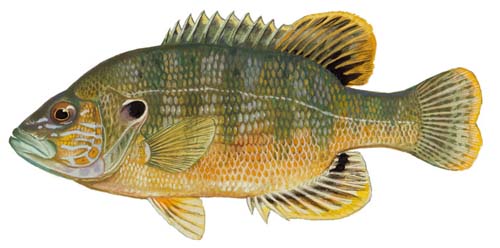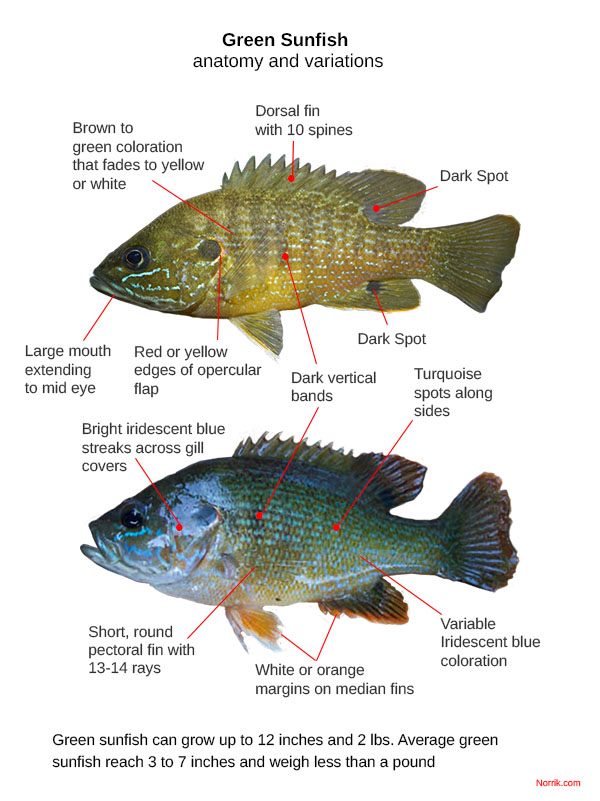The Green sunfish is a small panfish that makes tasty table fare and is a popular gamefish among anglers. It is most often found around structure in ponds, lakes and slow moving backwaters with there is sand, gravel, or bedrock bottoms. A bobber rig or jig baited with a small worm, cricket or natural bait is the best presentation for catching Green Sunfish.

How to identify Green Sunfish
A green sunfish has a relatively large mouth that extends back to the middle of the eye. It has a stout body similar to that of a black bass. It ranges in color from brown to dark green and sometimes iridescent blue. It’s coloration fades to lighter green and yellow along its sides. The belly is pale yellow or white. It may have areas of blue/green markings on its heads as well as darker vertical bands along its sides. Close inspection will reveal scattered turquoise spots along its scales. The spots may be more or less prominent in different fish.

Along the gill covers and sides of the head green sunfish often have nonsymmetrical bright blue stripes. At the back of the dorsal fin and base of the anal fin is a distinct dark spot. The dorsal fin has 10 spines and extends from near the middle of the back to the caudal peduncle. Pectoral fins are short, rounded and have 13 to 14 rays.
In the wild, green sunfish will grow to about 10 inches, but they average between 3 and 7 inches. A few specimens over 12 inches and weighing over 2 pounds have been reported by anglers. Adult green sunfish rarely weigh over a pound. Pan fried green sunfish makes a delectable table fare, but given their small size, you’ll need to catch several to make a meal of them.
Green sunfish are often confused with bluegill. They’re both a species of sunfish and they look similar. Bluegill are typically larger than green sunfish. Green sunfish have a relatively large mouth, where the mouth of the bluegill is proportionately smaller relative to its body. Finally, bluegill have clear to dusky median fins where green sunfish have fins that are darker and have orange or white margins.
Where to catch Green Sunfish
Green sunfish can be found in pounds, lakes and slow flowing waterways throughout the eastern, northeastern and central U.S. Their range extends as far west as California, but concentrations and availability dwindles moving from the Midwest into the Rocky Mountains and western states.

Ponds, lakes, and slow moving backwaters are the preferred habitat for green sunfish. They’re typically found over sand, gravel, or bedrock bottoms near structure such as submerged branches and logs, weed piles, vegetation, and rocks. They prefer clean water but can tolerate stained and muddied waters.
The following are habitats where you can catch Green Sunfish:
- Cliffs and Steep Shore Banks
- Freshwater Lakes and Ponds
- Freshwater Weed Beds
- Gradual Shores
- Lake and Pond Fishing Holes
- Lily Pads
- Open Water
- Overhanging Trees and Bushes
- Piers, Docks and Pilings
- Points and Break Lines
- Rocks
- Springs Holes
- Sunken Objects
- Walkways and Bridges
How to catch Green Sunfish
Green sunfish are one of the easier panfish catch. Notwithstanding, they can be difficult to target individually in waters where there are other panfish present, such as bluegill or crappie, that will readily take any bait intended for sunfish. Anglers typically catch green sunfish while targeting other perch and panfish species.
One of the most simple and effective methods for catching sunfish is using a good old fashion bobber rig affixed with a size 10 or 12 hook, and a small worm. A piece of cut night crawler, small cricket, or other natural bait can be used in place of a worm, but sunfish really like those worms. It helps to bob the bait a little to give it some movement—especially if it’s dead.
Fishing small artificial lures including jigs and spinners is also productive for catching green sunfish. And for you fly fishing aficionados out there, some good news. Green sunfish will readily take flies, including dry flies, nymph imitations, and midge larvae. Just your fly in front of the sunfish and it should bite.
If you plan to release your catch, a pair of hemostats or some other hook removal tool is a must to ensure a safe release.
The following are effective fishing methods and techniques for catching Green Sunfish:
Best Bait, Lures & Tackle
The most effective bait to use for green sunfish is live bait, specifically small worms. However, pieces of nightcrawlers, mealworms, bloodworms, and waxworms are all good alternatives.
Green sunfish will take small jigs and flies. Jigs tend to perform better when tipped with a natural bait. If you’re going to practice catch and release, a barbless hook is recommended. Green sunfish are small, but they have large mouths that can take a size 8 to 12 hook.
Sunfish are small and heavy tackle is not required. A 1-,2-, or 3-weight, 7 foot rod with medium or slow action is sufficient. For fly casting you can use the same tackle you’d use when fishing small trout.
The following are fishing lures, bait and tackle that can be used to catch Green Sunfish:



